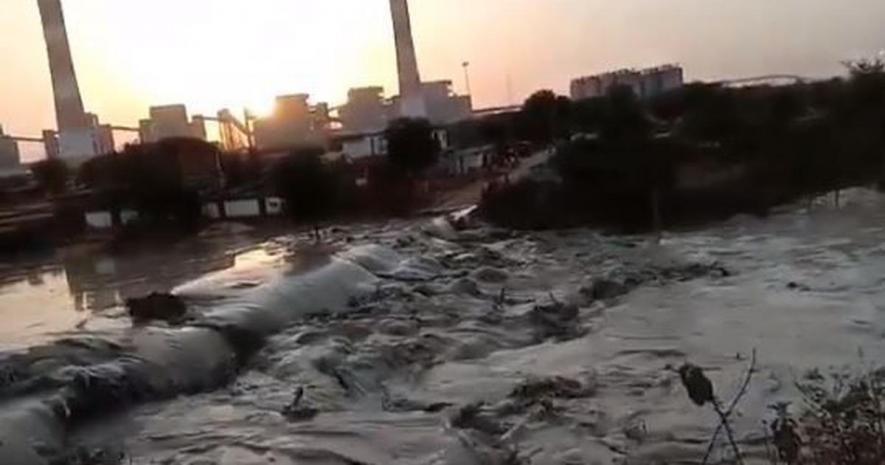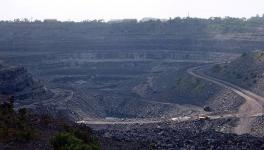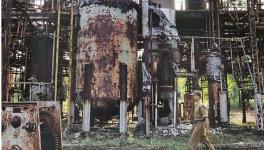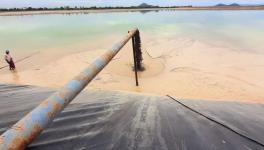Singrauli’s Fly Ash Flood was an Industrial Disaster Waiting to Happen

Image Courtesy: Scroll
New Delhi: On April 10, there was a fly ash slurry flood in Madhya Pradesh’s Singrauli district, in which three persons have been reported dead so far, out of the six people who went missing after the torrent hit: It was a disaster waiting to happen. The industrial accident isthe third such incident in the region in less than a year. It took place due to a breach in the dyke (dam) of the fly ash pond of the privately-owned 3,960-MW Sasan Ultra Mega Thermal Power Project (UMPP).
Nearly a dozen thermal power plants operate in the region spread across Singrauli district of Madhya Pradesh and Sonebhadra district of Uttar Pradesh, straddling inter-state boundaries. As per reports, thermal power plants have claimed that the dyke of Sasan UMPP could have given way because there had been heavy accumulation of fly ash over the past three weeks. It was reportedly put down to the absence of means of disposal due to the nationwide lockdown imposed to contain the coronavirus pandemic. However, Madhya Pradesh state government records point to the fact that the management of Sasan UMPP had paid no heed to repeated warnings to upgrade and strengthen the fly ash dykes in accordance with standards. Between October 2019 and December 2019, the district administration of Singrauli sent across five letters to Sasan UMPP, urging its management to strengthen and upgrade the dyke of the ash pond.
Following the incident on April 10, the district administration has issued a show-cause notice to Sasan UMPP, asking why its management did not strengthen the fly ash dyke despite notices. The administration has also ordered a magisterial enquiry into the incident.
“A third dead body, that of a woman aged around 30 years, has been recovered in addition to the two dead bodies that had been recovered earlier. Efforts are underway to trace the remaining three persons who had gone missing in the slurry floods. The magisterial enquiry will be completed within 45 days’ time,” said Singrauli District Magistrate K.V.S. Chaudhary on Wednesday. Experts pointed to the lack of proper guidelines for the construction of dykes or dams that contain fly ash, which is generated as waste material from thermal power plants.
“These are artificially created dykes or dams that hold millions of litres of toxic and carcinogenic slurry. Who is ensuring that these are designed, constructed, filled and operated properly? What are the norms? The Central Water Commission is an expert body on dams. But it has no role in thermal power projects. The Central Electricity Authority has no expertise on dams. The Central Pollution Control Board and the pollution control boards of MP and UP too have no expertise on dams. Each of these fly ash dams is a potential source of hazards,” sad Himanshu Thakkar of the South Asia Network on Dams, Rivers and People (SANDRP), an informal network of organisations and individuals working in the water sector and on issues pertaining to dams.
Two similar accidents have been reported from thermal power plants in the Singrauli-Sonebhadra region over the past eight months. In August 2019, a breach in the fly ash dyke of Essar’s thermal power plant in Singrauli had resulted in loss of crops and damage to houses due to the flooding of ash slurry. In October 2019, a flood caused by a breach in the fly ash dyke of a thermal power project of the National Thermal Power Corporation (NTPC) resulted in crop loss and the death of cattle in the adjoining areas.
As per an estimate, at least 35% of the coal used as input to generate electricity in a thermal power plant is converted into fly ash at the end of the procedure. The Union Ministry of Environment & Forests (MoEF) – as it was called backed then – had issued a notification in November 2009 which contained a set of detailed guidelines which promoted the use of fly ash in the manufacturing of building materials and in construction activity, within a specified radius of one hundred kilometres from coal, or lignite-based thermal power plants. The notification also contains a timeline over which all thermal power projects are required to dispose of the fly ash generated in their plants in a scientific manner, avoiding any kind of adverse environmental impact.
Locals fighting for the resettlement rights of those displaced for construction of the thermal power projects in the region, and against large-scale environmental pollution caused by these plants, allege that the guidelines to dispose fly ash are hardly followed in practice.
“Assuming that a quantity of around 15,000 to 16,000 metric tons of coal are required to be burnt in order to generate 1,000 MW of electricity over a period of 24 hours. An amount of 5,000 to 6,000 tons of fly ash will be generated as waste in one plant alone. At present, the combined capacity of all thermal power plants in the region is around 20,000 MW per day. This indicates that at least one lakh tons of fly ash is generated daily when the plants operate to their full potential,” said K.S. Sharma, convenor of the Udvasit Kisan Mazdoor Parishad, an organisation fighting for the rights of local citizens of the region.
Singrauli comes second in the list of the top ten critically polluted industrial clusters of the country, a ranking in which Ghaziabad district of UP occupies the first position, owing to the massive air and water pollution in the belt.
“Fly ash hangs in the air like mist. It’s in our food and water. The slurry that is emptied into the nearby Rihand Water Reservoir by the thermal power plants is the same source used for potable and drinking water by millions of people in the region. It is an expensive and time-consuming procedure to dispose of fly ash in a scientific manner. Sabotage behind breach of dykes to divert the slurry to the water reservoir cannot be ruled out,” added Sharma.
A Core Committee, under the Chairmanship of the Director of the Delhi-based National Environmental Engineering Research Institute (NEERI), was constituted by the National Green Tribunal in August 2014 to monitor the potential hazards of industrial development in Singrauli area. The panel had found prevalence of fluorosis among locals due to high concentration of fluoride in ground water in certain blocks of the district. During field visits, the committee also discovered mercury concentration above safe limits in samples of ground water collected from several villages. The committee had further observed that most of the ash ponds of the thermal power plants had attained their maximum height and saturation, and warned about a “worsening of the situation over the next five years, unless proper measures are taken to augment and accelerate the utilization of fly ash as per the [MoEF] notification of 2009”.
“The disposal of ash in the ash ponds along the Rihand Reservoir leads to silting of the Reservoir, in case of non-compliance of ash pond over flow discharge limit or any breach in ash dyke of the ash ponds. Concerned industries are required to follow the existing guidelines and cap the ponds,” the committee had further noted.
The committee had recommended that thermal power plants in the region formulate road maps for utilisation of fly ash in accordance with the MoEF notification of November 2009. Further, the panel had also recommended the installation of fly ash brick and block manufacturing units by thermal power plants, which could be used for building and other construction activities within a specified radius in accordance with the MoEF notification.
In August 2018, the National Green Tribunal formed an Oversight Committee, headed by Justice (Retired) Rajesh Kumar, former judge of Allahabad High Court, to monitor the implementation of the recommendations of the core committee that had been formed earlier.
Following the back-to-back incidents of breaches in ash dykes of two thermal power projects in Singrauli in the latter half of 2019, the Oversight Committee convened a meeting with representatives of all power plants in the region on October 22, 2019. During its earlier visits to the region, the panel had found a fall in water volumes of the Rihand Reservoir due to the continuous draining of slurry into it. In their minutes of the meeting the panel recorded that its visits to the Singrauli-Sonebhadra region over a year revealed fly ash as the main source of air and water pollution. Affidavits sought from the power plants that their effluents were not being emptied into the Rihand Reservoir had never been submitted, thereby necessitating a meeting with the representatives.
Taking note of the two accidents reported prior to the meeting, the panel noted that it was indicative of an improper and unscientific design of the ash dykes. Each thermal power plant was asked to submit affidavits, containing as many as eight queries, to prove that their dykes were scientifically designed and were adequate to deal with the fly ash generated. The minutes of the meeting recorded the following observation about the Sasan UMPP:
“The representative of the plant submitted the affidavit. However, the report of the third party agency certifying the structural stability of the fly ash dykes has not been submitted. They have also not submitted the reply of each and every point raised in the agenda. The representative states that they will get the report about the structural stability of the fly ash dykes and give the reply of each and every point raised in the agenda within one month.”
Generation of fly ash and its unscientific disposal has continued despite three incidents of fly ash dyke breach reported over a year. Following the dyke breach at NTPC thermal plant in October last year, a civil writ petition had been filed in the Supreme Court by environment lawyer Ashwani Dubey, demanding for restrain among thermal power plants of the Singrauli-Sonebhadra region from disposing fly ash, toxic residue and industrial waste into the Rihand Reservoir and other water bodies. The apex court dismissed the petition giving liberty to Dubey to file the case at the green tribunal. The tribunal, which is hearing the matter, has imposed Rs 10 crore as an interim penalty to be paid by the NTPC as per the ‘polluter pays principle’. “We are preparing to file a petition of habeas corpus for those who are still missing following the fly ash dyke breach that was reported in the Sasan power project last week,” said Dubey.
The author is an independent journalist.
Get the latest reports & analysis with people's perspective on Protests, movements & deep analytical videos, discussions of the current affairs in your Telegram app. Subscribe to NewsClick's Telegram channel & get Real-Time updates on stories, as they get published on our website.
























